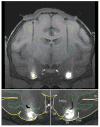Differential effects of m1 and m2 receptor antagonists in perirhinal cortex on visual recognition memory in monkeys
- PMID: 22561485
- PMCID: PMC3389587
- DOI: 10.1016/j.nlm.2012.04.007
Differential effects of m1 and m2 receptor antagonists in perirhinal cortex on visual recognition memory in monkeys
Abstract
Microinfusions of the nonselective muscarinic antagonist scopolamine into perirhinal cortex impairs performance on visual recognition tasks, indicating that muscarinic receptors in this region play a pivotal role in recognition memory. To assess the mnemonic effects of selective blockade in perirhinal cortex of muscarinic receptor subtypes, we locally infused either the m1-selective antagonist pirenzepine or the m2-selective antagonist methoctramine in animals performing one-trial visual recognition, and compared these scores with those following infusions of equivalent volumes of saline. Compared to these control infusions, injections of pirenzepine, but not of methoctramine, significantly impaired recognition accuracy. Further, similar doses of scopolamine and pirenzepine yielded similar deficits, suggesting that the deficits obtained earlier with scopolamine were due mainly, if not exclusively, to blockade of m1 receptors. The present findings indicate that m1 and m2 receptors have functionally dissociable roles, and that the formation of new visual memories is critically dependent on the cholinergic activation of m1 receptors located on perirhinal cells.
Published by Elsevier Inc.
Conflict of interest statement
The authors declare they have no competing financial interests.
Figures


Similar articles
-
Different roles for M1 and M2 receptors within perirhinal cortex in object recognition and discrimination.Neurobiol Learn Mem. 2014 Apr;110:16-26. doi: 10.1016/j.nlm.2014.01.002. Epub 2014 Jan 24. Neurobiol Learn Mem. 2014. PMID: 24462721
-
Methoctramine moderately improves memory but pirenzepine disrupts performance in delayed non-matching to position test.Eur J Pharmacol. 1997 Aug 27;333(2-3):129-34. doi: 10.1016/s0014-2999(97)01134-5. Eur J Pharmacol. 1997. PMID: 9314025
-
The time course of transmitter release in mouse motor nerve terminals is differentially affected by activation of muscarinic M1 or M2 receptors.Eur J Neurosci. 2007 Oct;26(8):2160-8. doi: 10.1111/j.1460-9568.2007.05770.x. Eur J Neurosci. 2007. PMID: 17953614
-
Activation of muscarinic M3-like receptors and beta-adrenoceptors, but not M2-like muscarinic receptors or alpha-adrenoceptors, directly modulates corticostriatal neurotransmission in vitro.Neuroscience. 1999 Apr;90(1):95-105. doi: 10.1016/s0306-4522(98)00447-3. Neuroscience. 1999. PMID: 10188937
-
Contribution of M1 and M2 muscarinic receptor subtypes to convulsions in fasted mice treated with scopolamine and given food.Behav Brain Res. 2019 May 17;364:423-430. doi: 10.1016/j.bbr.2017.11.018. Epub 2017 Nov 20. Behav Brain Res. 2019. PMID: 29158113
Cited by
-
Blockade of glutamatergic transmission in perirhinal cortex impairs object recognition memory in macaques.J Neurosci. 2015 Mar 25;35(12):5043-50. doi: 10.1523/JNEUROSCI.4307-14.2015. J Neurosci. 2015. PMID: 25810533 Free PMC article.
-
Intrahippocampal blockade of nicotinic or muscarinic receptors fails to impair nonnavigational spatial memory in macaques.Behav Neurosci. 2021 Aug;135(4):581-590. doi: 10.1037/bne0000444. Epub 2021 Feb 25. Behav Neurosci. 2021. PMID: 33630614 Free PMC article.
-
Benchmarking ligand-based virtual High-Throughput Screening with the PubChem database.Molecules. 2013 Jan 8;18(1):735-56. doi: 10.3390/molecules18010735. Molecules. 2013. PMID: 23299552 Free PMC article.
-
Memory loss in a nonnavigational spatial task after hippocampal inactivation in monkeys.Proc Natl Acad Sci U S A. 2014 Mar 18;111(11):4315-20. doi: 10.1073/pnas.1320562111. Epub 2014 Mar 3. Proc Natl Acad Sci U S A. 2014. PMID: 24591610 Free PMC article.
-
Antiamnesic and Neuroprotective Effects of an Aqueous Extract of Ziziphus jujuba Mill. (Rhamnaceae) on Scopolamine-Induced Cognitive Impairments in Rats.Evid Based Complement Alternat Med. 2021 Aug 10;2021:5577163. doi: 10.1155/2021/5577163. eCollection 2021. Evid Based Complement Alternat Med. 2021. PMID: 34422074 Free PMC article.
References
-
- Aigner TG, Mishkin M. The effects of physostigmine and scopolamine on recognition memory in monkeys. Behav Neural Biol. 1986;45(1):81–87. - PubMed
-
- Aigner TG, Walker DL, Mishkin M. Comparison of the effects of scopolamine administered before and after acquisition in a test of visual recognition memory in monkeys. Behav Neural Biol. 1991;55(1):61–67. - PubMed
-
- Alcantara AA, Mrzljak L, Jakab RL, Levey AI, Hersch SM, Goldman-Rakic PS. Muscarinic m1 and m2 receptor proteins in local circuit and projection neurons of the primate striatum: anatomical evidence for cholinergic modulation of glutamatergic prefronto-striatal pathways. J Comp Neurol. 2001;434(4):445–460. - PubMed
-
- Birdsall NJ, Curtis CA, Eveleigh P, Hulme EC, Pedder EK, Poyner D, et al. Muscarinic receptor subtypes and the selectivity of agonists and antagonists. Pharmacology. 1988;37(Suppl 1):22–31. - PubMed
Publication types
MeSH terms
Substances
Grants and funding
LinkOut - more resources
Full Text Sources

